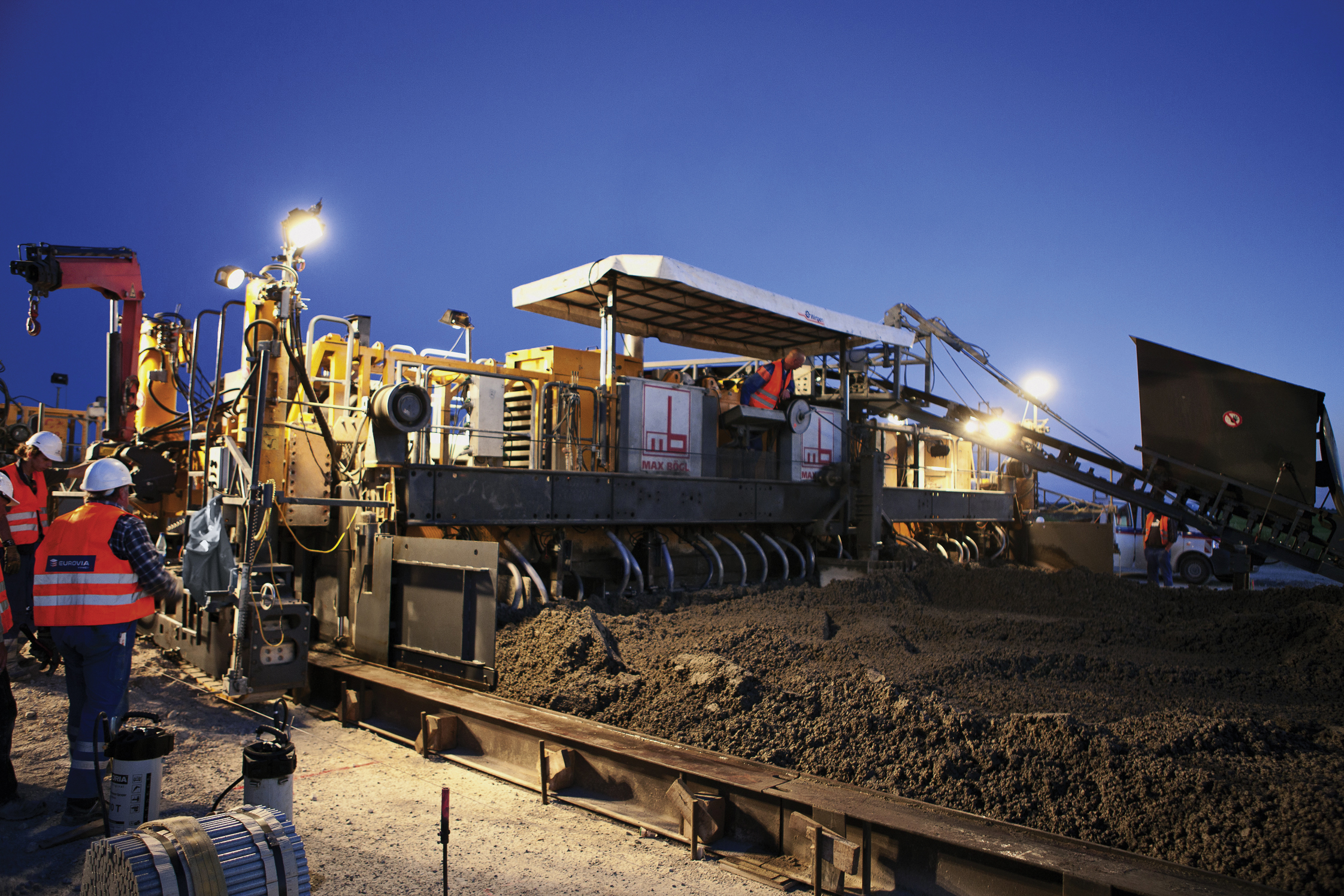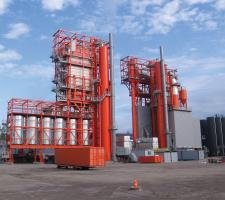
Airport construction and expansion is required to cater for more passengers and larger planes. Patrick Smith reports
The jv picked up the runway extension at Birmingham International Airport, England, and the nearby A45 transport corridor improvement schemes following a competitive tender process run by Birmingham City Council.
The two projects are being developed in conjunction due to their close proximities and timeframes, and will provide a number of benefits for both contracting parties.
The benefits include increased purchasing power, combining utility diversion works, reducing construction overhead costs and minimising the need to export and import earthworks materials.
The A45 has to be moved before the runway extension can be built, and some 500,000m³ of earthworks will be excavated for the road with all but contaminated material remaining on site. The best material won on site is to be placed as structural fill under the runway, and lesser material will be used as environmental bunds around the enlarged airfield perimeter.
Work on the A45 scheme, which has started, will reduce congestion, improve safety and accessibility and is a major catalyst for investment. It is expected to be completed by mid-2013.
The estimated start date for the runway extension scheme is June 2013, with an operational date of early 2014 following full commissioning and flight testing.
On completion, the 405m runway extension will enhance the airport’s capability and open up the world to the people and economy of the Midlands [region of England] as well as helping to take pressure off airports in the overheated south-east.
At just 2,600m, the current runway length restricts the range of destinations, markets and routes which can be served directly from the airport, resulting in thousands of people each year having to make long surface journeys to other UK airports outside the Midlands.
To have unlimited aircraft types flying directly to long-haul routes requires a longer take-off distance to enable aircraft to take off with a full payload.
While the airport can currently serve short and medium-haul routes into the UK and Europe, as well as limited long-haul routes to the east coast of North America and the Middle East, thriving business and leisure destinations further away, such as China, South Africa and the west coast of America, cannot be reached directly.
The runway extension works are currently estimated at £33 million (€42.3 million) and the airport is making a further investment of £13 million (€16.7 million) for the construction of a new air traffic control tower and radar system, which will be operational in 2013, and £9 million (€11.5 million) in a resurfacing of the runway.
A previous project at the airport (BHX) to create an asphalt material capable of withstanding the high stress turning forces of high-axle loading vehicles involved three taxiways in a major international airport, Birmingham for which the contractor was Fitzpatrick and architect
Bardon Airflex was promoted to BHX by
The success of Bardon Airflex in dealing with this challenge led to BHX requesting that the material be laid over a much larger area.
Bardon Airflex was laid to a depth of 40mm on the Whiskey, Victor and Echo taxiways. The aggregate used had a nominal size of 10mm and was sourced from Aggregate Industries Bardon Hill Quarry.
Construction on Victor and Echo involved a full depth reconstruction of the pavement structure that utilised a 60mm layer of Bardon Airmat as a binder course; a 70-170mm layer of 20mm HDM as a base and a geotextile.
“One of the most pleasing aspects of the contract was the clear demonstration of Aggregate Industries ability to take an immediate solution to a client to solve an outstanding problem,” said Bardon Contracting.
The new surfacing application of Bardon Airflex at BHX was the first of its kind in an airfield application in the UK.
Bardon Airflex, a heavy-duty asphalt range for airfield applications, has been designed to withstand high-axle loading and stresses. The product was initially installed at BHX in areas of the Whiskey taxiway where aircraft are pushed at 90° from parking stands by powerful, low-profile vehicles called tugs.
This process (called pushback in the aviation industry) exerts considerable turning pressures.
Bardon Airflex can utilise a binder designed to remain stable over a wide temperature range, enabling it to cope with hot surface temperatures.
It was subsequently used for the successful resurfacing of BHX’s larger Victor taxiway and on a stretch of the Echo taxiway.
Bardon Airflex was manufactured at Bardon Hill, County Leicestershire, England, with a
Finnish contractor
The plant features a total capacity of 720tonnes/hour and comprises two systems joined together, one with a 400tonne/hour mixer and the other with a 320tonne/hour mixer
Lemminkäinen’s contract includes paving milling as well as paving work for runway three and taxiways at Helsinki-Vantaa airport in the capital, an important traffic hub for Finland with around 15 million passengers passing through the facility in 2011.
Lemminkäinen began its operations on the €20 million paving contract in April 2012 and the work is expected to end in the autumn of 2014.
According to preliminary calculations, the work will involve around 300,000tonnes of paving. Finavia also pointed out that to minimise disruption, it is important that the changes are carried out as fast, cost-efficiently and safely as possible. And because of the scale of the work required and the short paving window due to Finland’s cold winter climate, the contractor opted to set up a large scale asphalt plant on-site.
The twin tower system stands close to 60m high and was erected to supply material in the quantities required for the paving work.
Of note is the fact that both plants are equipped with recycled asphalt pavement (RAP) drums and one features a filler heating system and a mastic asphalt storage agitator silo. In addition, a polymer plant is located directly alongside the asphalt plant to speed material supply and optimise operating efficiency.
The contract is based on the partnership model and is of major significance to both Finavia and Lemminkäinen. The partnership between customer and contractor is believed to be the first of its kind in the Finnish paving sector.
While the official opening of Berlin-Brandenburg International Airport, Germany, has been put back, possibly until next year, work on the runways/taxiways is complete.
To implement the large-scale project, contractors Gebrüder von der Wettern,
The companies owned large
Some 600,000m³ of pavement concrete was used over the entire project term.
The new 4,000m-long southern runway encompasses an area of 240,000m² and is 60m wide. A 130cm thick pavement structure in concrete design was realised both on the southern runway and in all of the other movement areas to enable giant aircraft such as the A 380 to land and take off.
In a first step, the 50cm-thick bottom layer, which contained both non-cohesive and cohesive soil, was improved and stabilised using cement. The next 15cm-thick layer comprised a stabilised mixture of hydrophobic cement and frost-proof sand with stabilisation carried out by several Wirtgen WR 2500 S soil stabilisers.
This was followed by a 25cm-thick hydraulically bound base layer. In a final step, the slipform pavers placed a 40cm-thick concrete layer between vertical formwork with sinusoidal cross-section.
Air-entrained crushed aggregate concrete, capable of taking extremely high loads was used, with cement, sand and aggregate supplied by rail to the concrete plants.
At times as many as three large slipform pavers, an SP 1500 L, an SP 1500 and an SP 1600, were in operation on the runways and taxiways at the same time, paving the concrete in a single-course, dual-layer operation, which means that one and the same type of concrete is used for both concrete layers (33cm bottom layer and 7cm top layer). Between the two layers, the dowel bars are positioned at evenly spaced intervals by the automatic dowel bar inserter (DBI).














